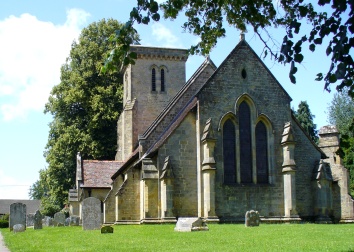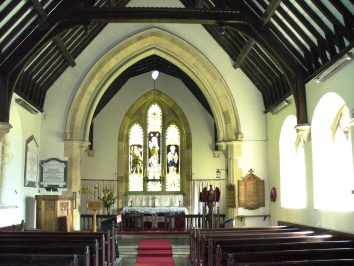Iping – St Mary
Among the long, narrow parishes of the Western Rother, Iping is the most extreme in shape, stretching north to the county boundary, with an average width of under 1/2 mile. The present church is C19, but stands on the same site by a bridge as its mediaeval predecessor. The Sharpe Collection drawing (1804) shows this had both nave and chancel, the latter with lancets. However, by Horsfield’s (I p102) time, there was probably no chancel. Foundations uncovered in the 1886 rebuilding included pilaster-strips (1 p45), possibly a sign of pre-Conquest work and almost certainly C11. There are said to have been some indeterminate wall paintings (SAC 43 (1900) p250).
The first replacement for this church was built in 1839-40 by T Greenshields of Oxford (ICBS) and Quartermain ((W) p133) shows it to have been typical of its period, with lancets and a cruciform plan. Only the tower remains, with a top that was always flat and had a corbelled out parapet. Its most striking feature is the plain tower arch, rising to the full height of the church at the level of the bell-chamber. It is likely that Greenshields received the commission as he had in 1838-39 designed a new rectory here (Colvin 4th ed p449) and most of his buildings outside the Oxford area were rectories or vicarages.
After barely 40 years Greenshields’s church was replaced on the grounds that it was unsafe (A 35 (1886) p9), though such was the change in taste that it is doubtful whether any great effort would have been made to preserve it. There may have been other considerations since the former church is said to have been appreciably larger, perhaps needlessly so. E P L Brock (B 48 (28 March 1885) p xxii) rebuilt it in 1885, the date on the south porch (in 1878 he had designed the chapel at Iping Marsh in the parish). The retained tower contrasts with Brock’s mostly conventional later C13-style detail, though both use local stone; the blocks in the tower are smaller and more regular. The chancel roof has arched transverse braces and the nave roof is also unusual for the period, with crenellated tiebeams on stone corbels. Both may have been re-used from Greenshield’s church, for hardly any new materials are said to have been required (ibid). The chancel arch is chamfered and moulded with conical corbels for the inner order.
Fittings and monuments
Chests: (Chancel) Two C17 ones.
Communion rails: C18.
Font: Round bowl with pointed arcading. Often called C13, but more probably C17.
Font cover: C17 open-arched.
Glass:
1. (East window) Ward and Hughes, 1894 (signed). Figures in predominantly dark tones set in clear glass.
2. (South nave, third window) Curtis, Ward and Hughes, 1901 (signed).
Monuments:
1. (Inside south porch and set in the east wall) Small C13 stone carved with a fleur-de-lis instead of the usual cross.
2. Wall tablet to Peter Bettesworth (see under Linch). He died in 1725, but the monument dates from after the death of his widow in 1772. Variegated grey marbles and of unusual elegance.
3. (Churchyard near south porch and now very weathered) Good tombstones, including a C18 one showing Death shooting an arrow at his shrinking victim.
Source
E P Loftus Brock: The Peculiarities of Sussex Parish Churches, JBAA 42 (1886) pp35-45
My thanks to Richard Standing for the photographs of the exterior and interior and that of the font.






